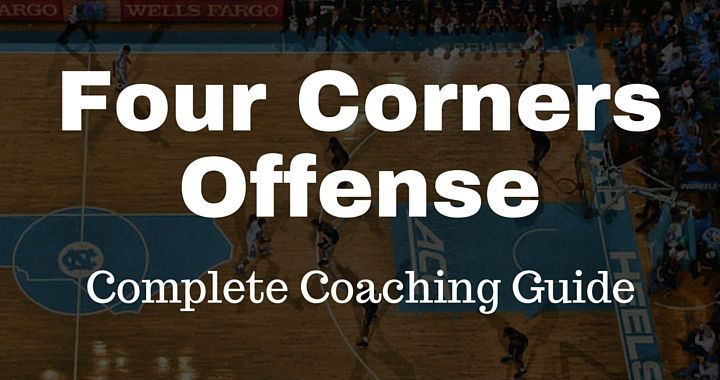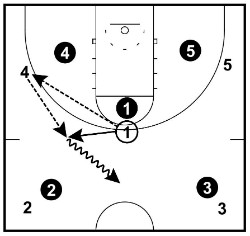The four corners offense was invented by John McClendon in the mid-1950’s but was made popular to the masses by Dean Smith during his long tenure at North Carolina.
The four corners offense was most commonly used as a delay offense before a 45-second shot clock was introduced in the 1985/1986 season. In fact, offenses like this one are the main reason that the shot clock was introduced to the game of basketball.
The offense involves four players standing on all the four corners of the half-court and one player with the basketball in the middle.
The player in the middle (who we refer to as the chaser) plays one-on-one with their immediate defender looking to break them down and score off the dribble. If another defender helps, then the pass is made to the open offensive player and the offense is reset.
It’s a very patient offense that was mostly used in the last few minutes of a game to maintain a lead.
The Biggest Misconception
One of the biggest misconceptions about this offense is that it was only used to slow down the game and that scoring opportunities weren’t meant to be pursued.
While delaying the game is the most common reason it’s implemented, the four corners offense can also be a great offense to score out of as long as the players keep an attacking mindset.
Teams would often use it when their star player significantly outmatched their direct opponent in a one-on-one situation.
The team would continually attack using this strategy in an attempt to get a high-percentage shot every time down the floor.
Dean Smith often went to this offense as a way to create scoring opportunities for his point guard, Phil Ford, during the 70’s.
Take a look at the video below and notice the different amount of scoring opportunities Ford is able to create using the four corners offense…
https://youtu.be/EtyyNd5Eoow
When to Use the Four Corners Offense
Since I don’t recommend this as a primary offense, here are the 5 main times throughout a game I’d recommend a coach consider implementing this offense:
1. To Run Time Off the Clock
Coaches would mostly use the four corners offense as a way to delay the game and run time off the clock. This was usually towards the end of a game but could be used at any time.
The theory behind running time off the clock is that the fewer possessions there are in a game, the less opportunity the opposition will have of scoring and reducing the lead.
The reason four corners is so effective at doing this is because the offensive team is spread out so much in the half-court. This gives the offense a lot of space to move which makes it extremely difficult for the defense to double team.
2. To Stop Momentum
If the opposition goes on a quick scoring run, coaches can run the four corners offense to slow the game down and put a stop to the opposition’s momentum.
This would calm both the offensive and defensive teams, quieten the opposition crowd, and take away the momentum that the offensive team had.
3. To Bring the Opposition Out of a Zone Defense
As I’ll bring up further in the blog post, coaches will often use the four corners offense to get the opposition out of zone by forcing them to play man-to-man and pressure the basketball.
Because if they don’t, the offensive team will simply hold the basketball while the time runs out.
4. If Your Best Players Get Into Foul Trouble
If a couple of the star players get into foul trouble, teams can use the four corners offense to slow the game down so that they don’t need to be subbed out of the game.
This stops the opposition from taking advantage of your bench players by attacking them while the better players were on the bench.
5. When Playing Against a Team with More Talent
The reason to implement the four corners offense when playing against a better team is to reduce the amount of possessions.
The fewer possessions there are in a game, the more chance the lesser skilled team has of staying competitive.
Roles and Responsibilities
Chaser
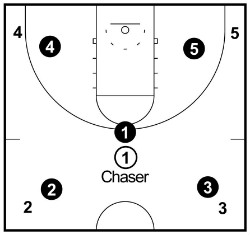 The chaser is the player in the middle of the four corners that will have the basketball in their hands most of the time. This is usually the point guard of the team but doesn’t have to be.
The chaser is the player in the middle of the four corners that will have the basketball in their hands most of the time. This is usually the point guard of the team but doesn’t have to be.
It is the chaser’s role to dominate the basketball by handling most of the dribbling and by creating shots for themselves and others.
This is the most important role on offense.
The players that make the best chasers have high ball-handling skills, are able to break their opponents down in a one-on-one situation, and have great decision-making skills.
Guards
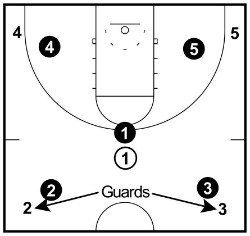 The guards are the two players in the corners of half-court and the sideline. The guards will also rotate through being chasers depending on where passes are made.
The guards are the two players in the corners of half-court and the sideline. The guards will also rotate through being chasers depending on where passes are made.
The main role of the guards is to space the floor and be in position to receive the pass from the chaser when they’re double-teamed.
The best guards have similar attributes to the chaser since they’ll have opportunities in that role also throughout the offense.
Posts
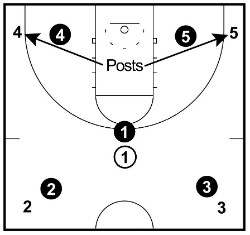 The posts are the two players in the corners of the baseline and the sideline.
The posts are the two players in the corners of the baseline and the sideline.
Their main roles are to space the floor for the chaser, finish around them rim on cuts, and also to challenge for the offensive rebounds.
The best posts have a high basketball IQ, are able to shoot from the outside so that the defenders are forced to play them close, and have high-energy.
How to Run the Four Corners Offense
Setting Up
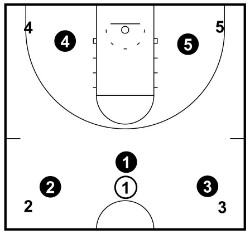 If you want to initiate the offense the same way that Dean Smith did, the four corners offense begins with the coach or point guard raising four fingers in the air as the signal.
If you want to initiate the offense the same way that Dean Smith did, the four corners offense begins with the coach or point guard raising four fingers in the air as the signal.
On this signal, the two post players move to the baseline corners and the two wings move to the half-court corners.
Each corner player should be a few feet in from the corner so that they have space to move when they need to.
The chaser then has the entire middle of the half-court either attack the ring one-on-one or dribble the basketball to delay the game.
Attacking the Middle
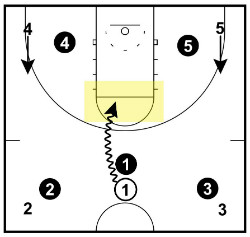 The chaser’s main objective is to attack the free-throw line area and then make decisions from there.
The chaser’s main objective is to attack the free-throw line area and then make decisions from there.
This is why the chaser must be highly skilled at dribbling the basketball and attacking their defender one-on-one.
While the chaser is dribbling towards the middle of half-court, the guards must stay in their corners but the posts should take a few steps up the sideline.
The reason the posts do this is to improve the passing angle, drag the post defenders up higher, and also to create space for the back-cut towards the rim.
Once they’ve dribble to the middle of the court, the chaser has a few options depending on how the defense reacts and the current game situation…
1. Attack the ring.
2. Pass to a guard.
3. Pass to a post.
4. Dribble back out.
Let’s discuss each option in more detail…
Option 1 – Chaser Attacks
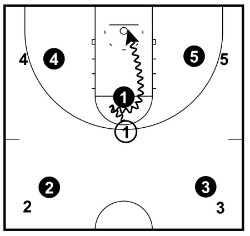 This is the first option that must be looked at if the team is looking to score the basketball.
This is the first option that must be looked at if the team is looking to score the basketball.
The chaser attacks one-on-one and creates a shot with a high percentage of success.
If the post defenders choose to deny the post players in the corners and not play help defense on the chaser, this will often result in a high-percentage layup as long as you’re attacking the right matchup.
Option 2 – Pass to a Guard
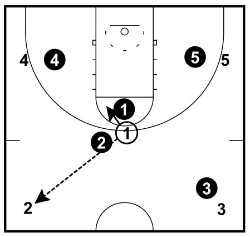 If the chaser dribbles to the middle of the floor and finds one of the guard defenders is coming to double them, they must immediately pass out to the open offensive player before the double team arrives.
If the chaser dribbles to the middle of the floor and finds one of the guard defenders is coming to double them, they must immediately pass out to the open offensive player before the double team arrives.
Once the pass to the open guard has been made, the chaser moves to the center of the half-court so that the guard has space to dribble either left or right.
The guard will wait until their defender closes out on them and then attacks the defenders hip preferably dribbling towards the middle of the court.
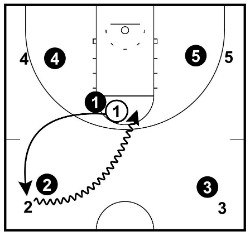 When they do this, the chaser curls the opposite way from them to create space and to fill their position so that, once again, there are four corners and a chaser.
When they do this, the chaser curls the opposite way from them to create space and to fill their position so that, once again, there are four corners and a chaser.
As you can see, the chaser will change throughout the offense when passes out are made. What’s important is that there are always four corner players and one chaser.
Option 3 – Pass to a Post
When the chaser has dribbled to the middle of the court, they may get doubled by a post defender or may be able to create a play for a score with the post player.
The post player can move up the sideline to get open but must never go higher than the free-throw line.
On a pass to the post player, there are three main options they have:
1. Receive the pass and then immediately pass back to the chaser
The chaser can use the post-player as a pressure release by immediately cutting to space and receiving the basketball back to reset the offense.
After passing the basketball back, the post cuts back to the corner and once again spaces the court.
The chaser then dribbles the basketball back out and begins the offense again.
2. Backdoor cut towards the rim for a layup
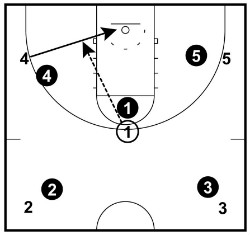 When the post players take a few steps up the sideline, often their defender will follow them expecting the outlet pass. They now have the perfect opportunity and space for a quick back-door cut where the chaser can pass to them for an open layup.
When the post players take a few steps up the sideline, often their defender will follow them expecting the outlet pass. They now have the perfect opportunity and space for a quick back-door cut where the chaser can pass to them for an open layup.
If a post player back-door cuts and doesn’t receive the basketball, they simply return to the corner that they started in.
3. Receive the pass and then attack one-on-one
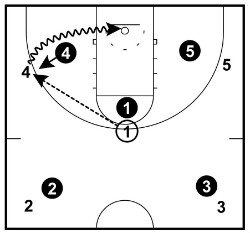 If you have any agile post players and can get a favorable matchup for them, allowing the post player to attack one-on-one can lead to a lot of success.
If you have any agile post players and can get a favorable matchup for them, allowing the post player to attack one-on-one can lead to a lot of success.
Coaches will often use this to single out a defender that’s in foul trouble and put pressure on them to receive another one or allow the open layup.
Option 4 – Dribble Back Out
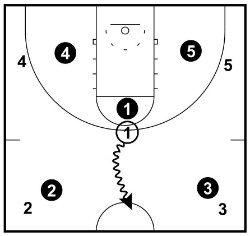 If the chaser drives the basketball to the middle and no defenders come to set the double team and they still have the dribble under control, they can simply retreat dribble back to near half-court to start the offense again.
If the chaser drives the basketball to the middle and no defenders come to set the double team and they still have the dribble under control, they can simply retreat dribble back to near half-court to start the offense again.
This is a good option if you have a great one-on-one player with high dribbling ability.
If you watched the video above, you’ll see Phil Ford do this often.
The 2 Best Opportunities to Score
The most important thing for players to know when running the four corners offense is that only shots with an extremely high probability of success should be attempted.
There is no shot clock so the offense must be very patient and wait for the right opportunity.
The two main shots you’re looking to take when running the four corners offense are:
1. High-percentage layups
2. Free throws
High percentage layups can come from the chaser driving to the hoop, off cuts from the post players, in one-on-one situations, etc.
Traditionally, long-distance shots are never to be taken. We would prefer to hold the basketball and reset the offense rather than shoot an open long-distance shot.
If you’re using this as a delay offense to waste the clock, eventually the opposition will be forced to foul and put your team at the foul line. For this reason, it’s super important that you have your best free-throw shooters on the court when running this offense.
3 Famous Four Corners Offense Games
1. North Carolina vs Duke – February 24th, 1979
When people first bring up the four corners offense, the game that often immediately springs to mind is a game between North Carolina and Duke.
While usually employed towards the end of the game, Dean Smith decided to use the four corners offense early in this matchup with Duke.
After Duke scored immediately from the tip, North Carolina stalled the game for the next 11 minutes using the four corners offense to bring Duke out of their 2-3 zone.
It didn’t work.
After a couple of turnovers and two air-balls, North Carolina ended up going into half-time down 7-0.
https://www.youtube.com/watch?v=YRVmc6dO0g8
2. North Carolina vs Virginia – March 7th, 1982
Another famous ‘four corners’ game occurred during the ACC championship game of 1982.
Dean Smith, Michael Jordan, and the Tarheels faced Terry Holland, Ralph Sampson, and the rest of the Cavaliers in an intense battle for the first 32 minutes of the game.
With 8 minutes remaining in the game and clinging to a 1-point lead, Dean Smith called a timeout and set the Tarheels up in the four corners offense.
Dean Smith’s goal of implementing four corners was to get the Cavaliers out of their zone defense (which featured 7″4′ Ralph Sampson in the middle) and force them to play man-to-man defense.
But Terry Holland and the Cavaliers refused to leave their zone defense or extend out.
The Tarheels held the basketball for the next 7 minutes and 6 seconds before the Cavaliers had no choice but to foul and send Doherty to the line for free throws.
North Carolina went on to win the game 47 – 45. When Dean Smith was asked about the four corners offense after the game he said “A coach thinks to win a game under the rules. We were just trying to win, and we did.”
Can’t argue with that response!
3. North Carolina vs Georgia Tech – 21st of February, 2015
After the passing of Dean Smith on the 21st of February, 2015, the current head coach of North Carolina, Roy Williams, ran the four corners offense on the first possession of a game against the Georgia Tech Yellow Jackets.
Just 10 seconds into the game, Roy Williams lifts 4 fingers into the air signaling the four corners offense to begin just like the great Dean Smith had done many times before.
Four North Carolina players spread out to the corners while point guard Marcus Paige handled the basketball in the middle of the floor.
The offense worked perfectly.
Marcus Paige was able to find Brice Johnson on a backdoor cut resulting in an easy layup.
A touching tribute to Dean Smith.
https://youtu.be/nJLj1SgD0eQ
Would I Recommend This Offense for Youth Basketball?
No. I would not recommend the four corners offense for a youth basketball team for a few reasons:
1. It’s boring basketball
There’s a very good reason why the shot clock was introduced to stop this delay-style of play.
While it is effective when used with the right players, it’s not very fun to watch. You won’t be making any friends with the spectators of the game if you choose to use this offense.
2. Poor for Player Development
Do you really want your players standing in the corners of the court while one player dribbles around in the middle wasting time off the clock?
It’s a good strategy for holding onto a lead, but it won’t do much for the future of your players.
This is why I would only ever recommend the four corners offense as a delay offense in the final minutes of a game. Never use it as a primary offense.
Conclusion
The four corners offense is effective but should not be used as your primary offense.
If you don’t have a shot clock in the league you coach, there’s no reason why you can’t implement this offense to use during the last few minutes of a game.
It’s simple to learn, creates high percentage shots, frustrates and fatigues the defense (Dean Smith spoke often about ‘teasing the defense), and much more.

